La tourbière de GAYME. EarthCache
-
Difficulty:
-

-
Terrain:
-

Size:  (other)
(other)
Please note Use of geocaching.com services is subject to the terms and conditions
in our disclaimer.
Tourbière de moyenne montagne.
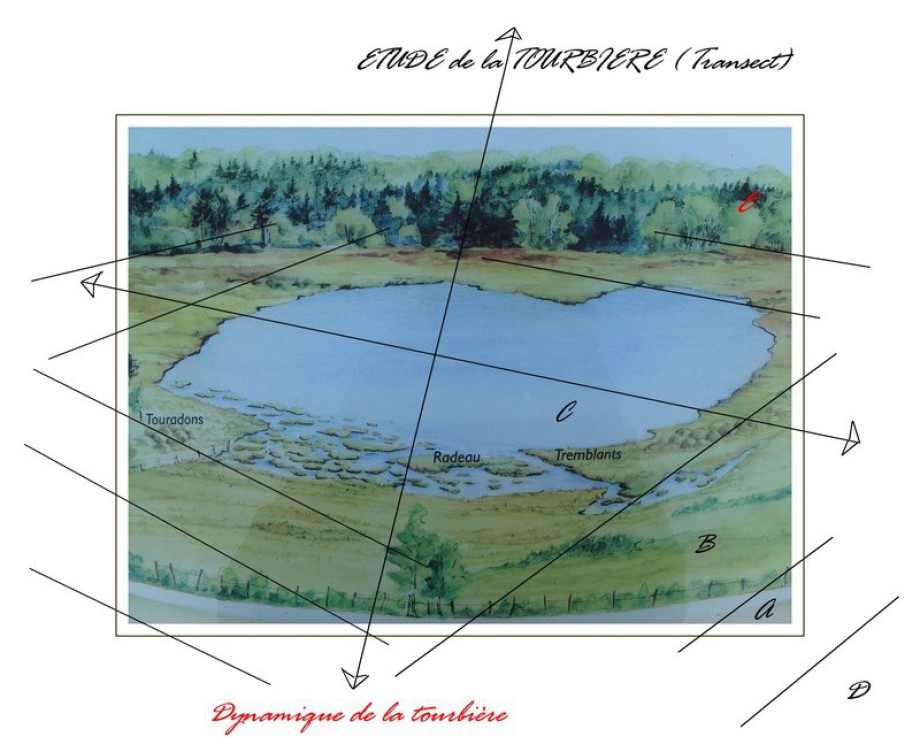 La région Auvergne est très riche en espaces en eau.On peut dénombrer environ 370 tourbières, toutes avec leurs cortèges de spécificités .Découvrez celle-ci en famille sur une courte rando.(4km)
La région Auvergne est très riche en espaces en eau.On peut dénombrer environ 370 tourbières, toutes avec leurs cortèges de spécificités .Découvrez celle-ci en famille sur une courte rando.(4km)
LA FORMATION D'UNE TOURBIERE en MOYENNE MONTAGNE.
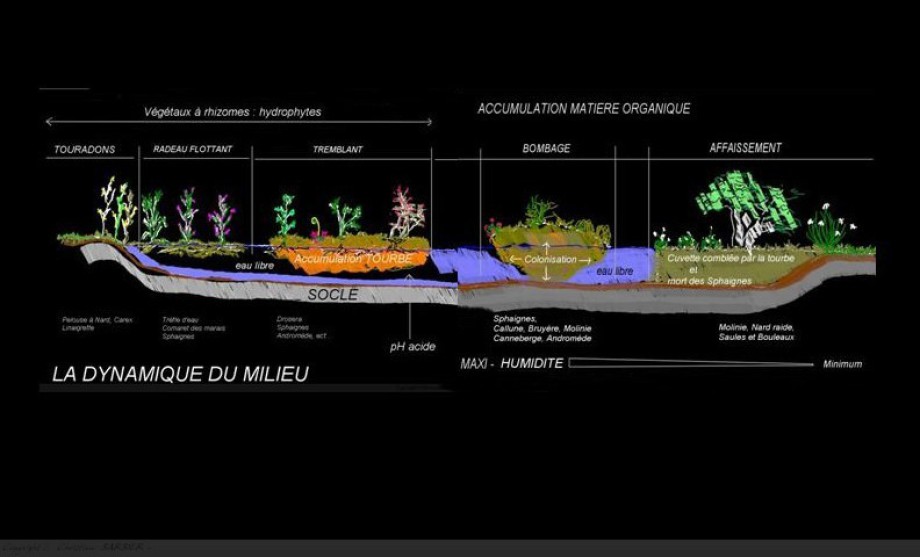 Pour qu'une tourbière se constitue, deux conditions doivent être réunies. La première: il faut que la production de matière organique soit supérieure à la décomposition. La deuxième: il faut que la présence d'eau soit suffisante en permanence pour éviter le processus d'évapotranspiration des végétaux. En fait, l'eau reste le facteur le plus important dans la genèse d'une tourbière. Pour que la production de matière organique soit supérieure à la décomposition, il faut que l'eau stagnante soit un milieu asphyxiant, c'est à dire, presque totalement dépourvu d'oxygène. Cette particularité joue un rôle essentiel dans le phénomène biochimique de la dégradation des plantes (Sphaignes) et le réduit à sa plus simple expression. De plus, l'eau de la tourbière est souvent acide, ce qui lui confère encore un facteur limitant dans la décomposition des plantes.
Pour qu'une tourbière se constitue, deux conditions doivent être réunies. La première: il faut que la production de matière organique soit supérieure à la décomposition. La deuxième: il faut que la présence d'eau soit suffisante en permanence pour éviter le processus d'évapotranspiration des végétaux. En fait, l'eau reste le facteur le plus important dans la genèse d'une tourbière. Pour que la production de matière organique soit supérieure à la décomposition, il faut que l'eau stagnante soit un milieu asphyxiant, c'est à dire, presque totalement dépourvu d'oxygène. Cette particularité joue un rôle essentiel dans le phénomène biochimique de la dégradation des plantes (Sphaignes) et le réduit à sa plus simple expression. De plus, l'eau de la tourbière est souvent acide, ce qui lui confère encore un facteur limitant dans la décomposition des plantes.
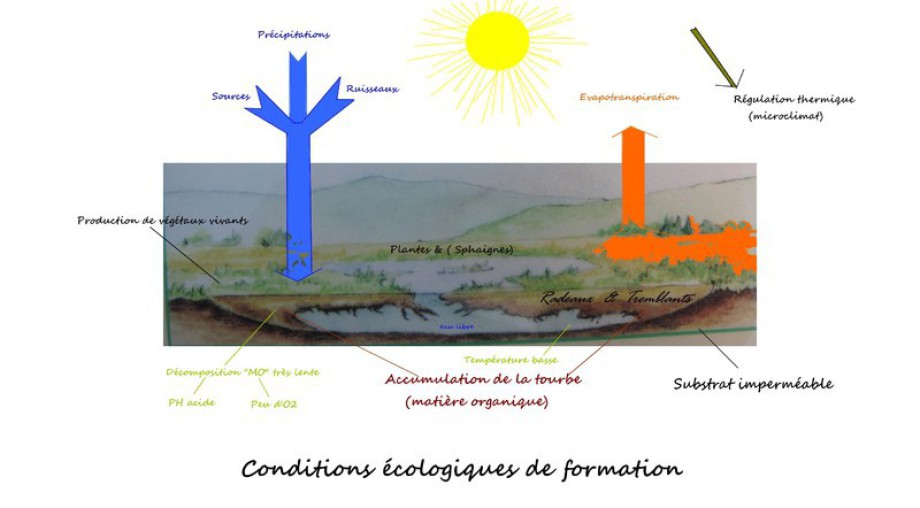 L'ORIGINE DANS LE TEMPS:
Il y a 12000 ans (le Würm), la glaciation prenait fin. L'action des glaciers allait bouleverser le paysage des massifs Auvergnats. Sur tous les substrats, la glace a usé et poli, mais aussi creusé et ouvert de profonde vallées, ainsi que de profondes dépressions où l'eau de fonte s'est retrouvée prisonnière du relief. Les produits de cette érosion ont tapissé le fond de ces cuvettes le rendant fortement perméable. Les conditions de pluviosité et de température ont favorisé la colonisation de ces retenues d'eau, par des plantes particulières tel-que : les Carex, Prêle, Callune, Molinie, puis par des arbrisseaux, comme l'aulne, le bouleau, et les saules).
L'ORIGINE DANS LE TEMPS:
Il y a 12000 ans (le Würm), la glaciation prenait fin. L'action des glaciers allait bouleverser le paysage des massifs Auvergnats. Sur tous les substrats, la glace a usé et poli, mais aussi creusé et ouvert de profonde vallées, ainsi que de profondes dépressions où l'eau de fonte s'est retrouvée prisonnière du relief. Les produits de cette érosion ont tapissé le fond de ces cuvettes le rendant fortement perméable. Les conditions de pluviosité et de température ont favorisé la colonisation de ces retenues d'eau, par des plantes particulières tel-que : les Carex, Prêle, Callune, Molinie, puis par des arbrisseaux, comme l'aulne, le bouleau, et les saules).
 La colonisation de ces espaces en eau, s'effectue, des bords, vers le centre en formant des ceintures de végétation, formées de plantes demeurant au niveau de l'eau. Les premières ceintures de végétation sont formées de Carex en grosses touffes, appelées "TOURADONS". Ensuite, apparaissent les mousses (les SPHAIGNES), qui colonisent l'espace en eau en s'implantant sur les plantes à long rizhomes et ainsi forment des tapis de végétations flottant et progressant en surface. Les Sphaignes, Famille des "Sphargnacées" ont une croissance très lente et limitée. L'accumulation de leur matière non décomposée dans l'ambiance particulièrement acide des tourbières, forme la tourbe. Cette plante est voisine des mousses. Les Sphaignes ont la particularité de pouvoir absorber (contenir) jusqu'à 40 fois leur poids en eau.
La colonisation de ces espaces en eau, s'effectue, des bords, vers le centre en formant des ceintures de végétation, formées de plantes demeurant au niveau de l'eau. Les premières ceintures de végétation sont formées de Carex en grosses touffes, appelées "TOURADONS". Ensuite, apparaissent les mousses (les SPHAIGNES), qui colonisent l'espace en eau en s'implantant sur les plantes à long rizhomes et ainsi forment des tapis de végétations flottant et progressant en surface. Les Sphaignes, Famille des "Sphargnacées" ont une croissance très lente et limitée. L'accumulation de leur matière non décomposée dans l'ambiance particulièrement acide des tourbières, forme la tourbe. Cette plante est voisine des mousses. Les Sphaignes ont la particularité de pouvoir absorber (contenir) jusqu'à 40 fois leur poids en eau.
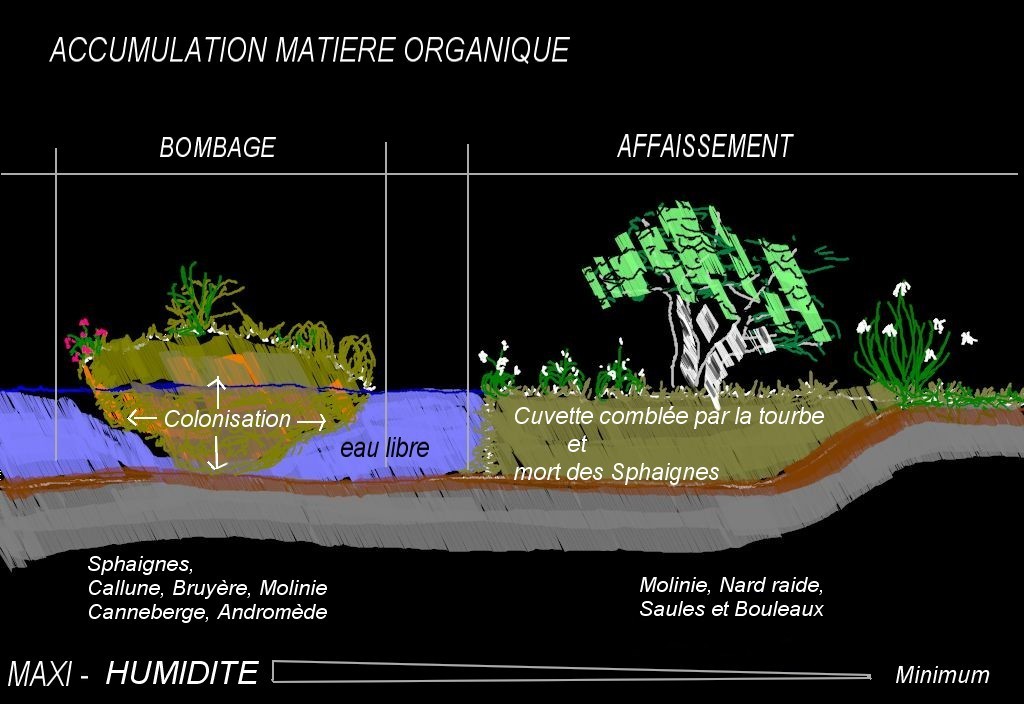 RAPPEL: Pas de boite à trouver !!! Et maintenant que les tourbières n'ont plus de secret pour vous, je vous invite à répondre aux questions suivantes:
RAPPEL: Pas de boite à trouver !!! Et maintenant que les tourbières n'ont plus de secret pour vous, je vous invite à répondre aux questions suivantes:
(rendez-vous au WP , vous y trouverez les réponses...)
1) De quand date cette tourbière ? (époque géologique et age)?
2) Expliquez à l'aide des images du panneau ci - dessous, les 3 phases d'évolution de la tourbière au fil du temps... (-10 000 ans / -5000 ans / aujourd'hui) 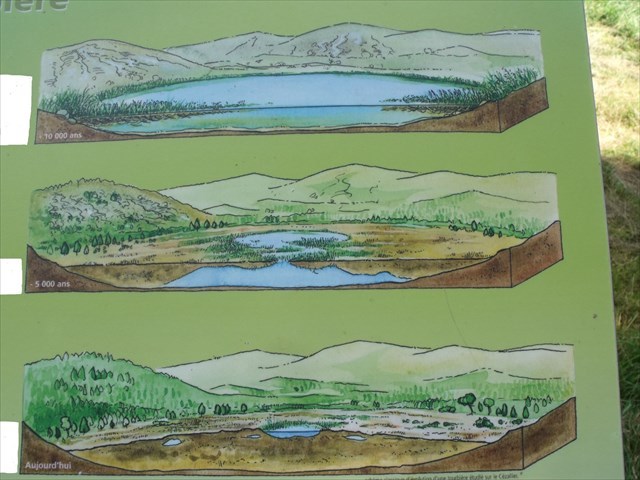
3) Pour expliquer une tourbière, c'est pas du gateau !!!
et pourtant si ... d'ailleurs on la compare au: ?
4) Nom de la mousse ayant colonisé la tourbière ?
5) Epaisseur de tourbe se formant chaque année sur le site (en mm)?
6) Photo optionnelle ...
Loguez cette cache "Found it" et envoyez-moi vos propositions de réponses soit via mon profil, soit via la messagerie geocaching.com (Message Center), et je vous contacterai en cas de problème.
BONNE DECOUVERTE...
 Mid-peat bog.
Mid-peat bog.
 The Auvergne region is very rich in water spaces.There are about 370 peat bogs, all with their processions of specificities. On a short hike. (4km)
FORMATION OF A MOUNTAIN MOUNTAIN TOURBIER
The Auvergne region is very rich in water spaces.There are about 370 peat bogs, all with their processions of specificities. On a short hike. (4km)
FORMATION OF A MOUNTAIN MOUNTAIN TOURBIER
 To create a bog, two conditions must be met. The first is that the production of organic matter must be superior to decomposition. The second is that the presence of water must be sufficient at all times to avoid the process of evapotranspiration of plants. In fact, water remains the most important factor in the genesis of a bog. In order for the production of organic matter to be superior to decomposition, stagnant water must be an asphyxiant medium, that is to say, almost totally devoid of oxygen. This characteristic plays an essential role in the biochemical phenomenon of plant degradation (Sphaignes) and reduces it to its simplest expression. Moreover, the water of the bog is often acid, which confers to him still a limiting factor in the decomposition of the plants.
To create a bog, two conditions must be met. The first is that the production of organic matter must be superior to decomposition. The second is that the presence of water must be sufficient at all times to avoid the process of evapotranspiration of plants. In fact, water remains the most important factor in the genesis of a bog. In order for the production of organic matter to be superior to decomposition, stagnant water must be an asphyxiant medium, that is to say, almost totally devoid of oxygen. This characteristic plays an essential role in the biochemical phenomenon of plant degradation (Sphaignes) and reduces it to its simplest expression. Moreover, the water of the bog is often acid, which confers to him still a limiting factor in the decomposition of the plants.  ORIGIN IN TIME:
12,000 years ago (the Würm), the glaciation came to an end. The action of the glaciers was going to upset the landscape of the Auvergne massifs. On all substrates, the ice has worn and polished, but also dug and opened deep valleys, as well as deep depressions where the meltwater found itself trapped in relief. The products of this erosion have lined the bottom of these cuvettes making it highly permeable. The rainfall and temperature conditions favored the colonization of these reservoirs by special plants such as Carex, Horsetail, Callune, Molinie, and then by shrubs, such as alder, birch, Willows).
ORIGIN IN TIME:
12,000 years ago (the Würm), the glaciation came to an end. The action of the glaciers was going to upset the landscape of the Auvergne massifs. On all substrates, the ice has worn and polished, but also dug and opened deep valleys, as well as deep depressions where the meltwater found itself trapped in relief. The products of this erosion have lined the bottom of these cuvettes making it highly permeable. The rainfall and temperature conditions favored the colonization of these reservoirs by special plants such as Carex, Horsetail, Callune, Molinie, and then by shrubs, such as alder, birch, Willows).
 The colonization of these spaces in water is effected from the edges towards the center by forming belts of vegetation, formed of plants remaining at the level some water. The first belts of vegetation are formed of Carex in large clumps, called "TOURADONS". Then, the mosses (the SPHAIGNES) appear, which colonize the space in water by implanting on the plants with long rizhomes and thus form carpets of floating vegetations and progressing on the surface. The Sphaignes, Family "Sphargnaceae" have a very slow and limited growth. The accumulation of their undecomposed matter in the particularly acidic environment of the peat bogs forms the peat. This plant is similar to mosses. Sphagnum mosses have the particularity of being able to absorb (contain) up to 40 times their weight in water.
The colonization of these spaces in water is effected from the edges towards the center by forming belts of vegetation, formed of plants remaining at the level some water. The first belts of vegetation are formed of Carex in large clumps, called "TOURADONS". Then, the mosses (the SPHAIGNES) appear, which colonize the space in water by implanting on the plants with long rizhomes and thus form carpets of floating vegetations and progressing on the surface. The Sphaignes, Family "Sphargnaceae" have a very slow and limited growth. The accumulation of their undecomposed matter in the particularly acidic environment of the peat bogs forms the peat. This plant is similar to mosses. Sphagnum mosses have the particularity of being able to absorb (contain) up to 40 times their weight in water.
 REMINDER: No box to find !!! And now that peat bogs have no more secrets for you, I invite you to answer the following questions:
REMINDER: No box to find !!! And now that peat bogs have no more secrets for you, I invite you to answer the following questions:
(Go to the WP, you will find the answers ...)
1) When did this peat bog? (Geological time and age)?
2) Explain with the images of the panel below, the 3 phases of evolution of the peat bog over time ... (-10 000 years / -5000 years / today)

3) To explain a bog, it is not cake !!!
And yet if ... besides it is compared to:?
4) Name of the foam that colonized the bog?
5) Peat thickness forming each year on site (in mm)?
6) Optional photo ...
Log in this "Found it" cache and send me your suggestions for answers either via my profile or via the geocaching.com message center, and I will contact you if there is a problem. GOOD DISCOVERY ...
 BELLE BALADE, JE VOUS ATTENDS.../BEAUTIFUL BALAD, I WAIT YOU ..
BELLE BALADE, JE VOUS ATTENDS.../BEAUTIFUL BALAD, I WAIT YOU ..
Additional Hints
(Decrypt)
Cbhe ovra pbzceraqer yr zvyvrh qr yn gbheovèer, snver yn obhpyr wnybaaér qr 10 genqvf rg gebhire yr cnaarnh...
********************************
Gb haqrefgnaq gur zvqqyr bs gur obt, znxr gur ybbc znexrq jvgu 10 genqvf naq svaq gur cnary ...